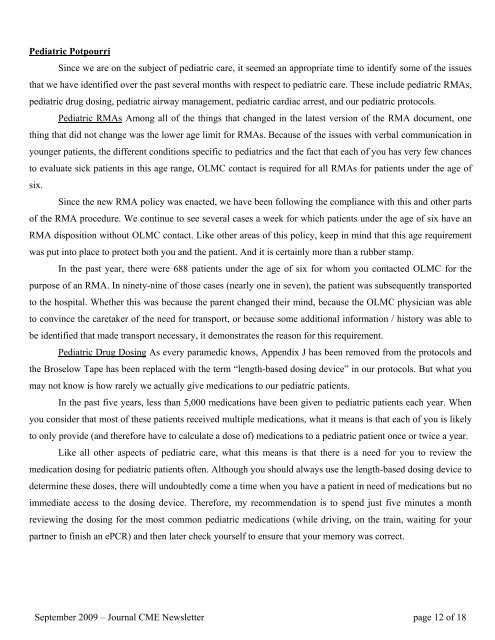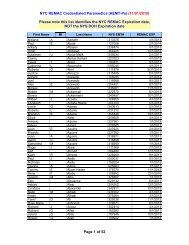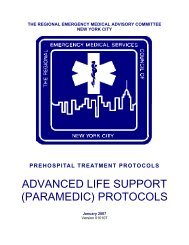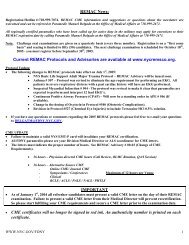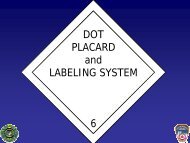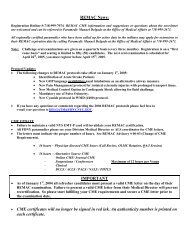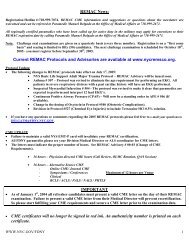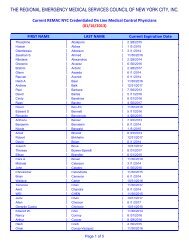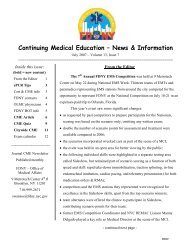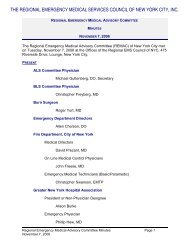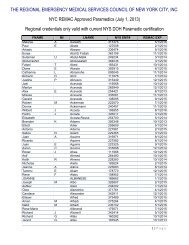Continuing Medical Education - News & Information - The Regional ...
Continuing Medical Education - News & Information - The Regional ...
Continuing Medical Education - News & Information - The Regional ...
You also want an ePaper? Increase the reach of your titles
YUMPU automatically turns print PDFs into web optimized ePapers that Google loves.
Pediatric PotpourriSince we are on the subject of pediatric care, it seemed an appropriate time to identify some of the issuesthat we have identified over the past several months with respect to pediatric care. <strong>The</strong>se include pediatric RMAs,pediatric drug dosing, pediatric airway management, pediatric cardiac arrest, and our pediatric protocols.Pediatric RMAs Among all of the things that changed in the latest version of the RMA document, onething that did not change was the lower age limit for RMAs. Because of the issues with verbal communication inyounger patients, the different conditions specific to pediatrics and the fact that each of you has very few chancesto evaluate sick patients in this age range, OLMC contact is required for all RMAs for patients under the age ofsix.Since the new RMA policy was enacted, we have been following the compliance with this and other partsof the RMA procedure. We continue to see several cases a week for which patients under the age of six have anRMA disposition without OLMC contact. Like other areas of this policy, keep in mind that this age requirementwas put into place to protect both you and the patient. And it is certainly more than a rubber stamp.In the past year, there were 688 patients under the age of six for whom you contacted OLMC for thepurpose of an RMA. In ninety-nine of those cases (nearly one in seven), the patient was subsequently transportedto the hospital. Whether this was because the parent changed their mind, because the OLMC physician was ableto convince the caretaker of the need for transport, or because some additional information / history was able tobe identified that made transport necessary, it demonstrates the reason for this requirement.Pediatric Drug Dosing As every paramedic knows, Appendix J has been removed from the protocols andthe Broselow Tape has been replaced with the term “length-based dosing device” in our protocols. But what youmay not know is how rarely we actually give medications to our pediatric patients.In the past five years, less than 5,000 medications have been given to pediatric patients each year. Whenyou consider that most of these patients received multiple medications, what it means is that each of you is likelyto only provide (and therefore have to calculate a dose of) medications to a pediatric patient once or twice a year.Like all other aspects of pediatric care, what this means is that there is a need for you to review themedication dosing for pediatric patients often. Although you should always use the length-based dosing device todetermine these doses, there will undoubtedly come a time when you have a patient in need of medications but noimmediate access to the dosing device. <strong>The</strong>refore, my recommendation is to spend just five minutes a monthreviewing the dosing for the most common pediatric medications (while driving, on the train, waiting for yourpartner to finish an ePCR) and then later check yourself to ensure that your memory was correct.September 2009 – Journal CME <strong>News</strong>letter page 12 of 18


